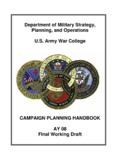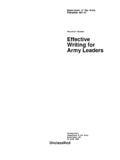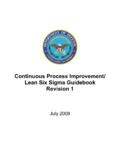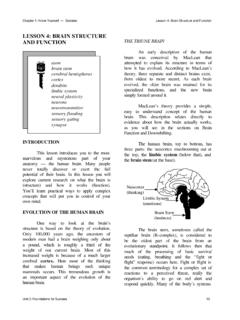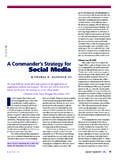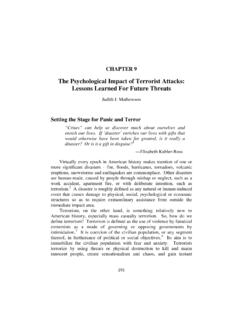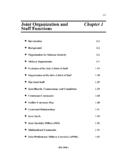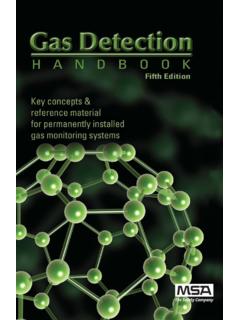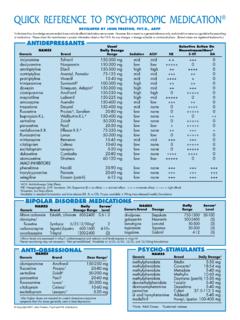Transcription of Commander's Battle Staff Handbook
1 Research ProductCommander's Battle StaffHandbookWith Garrison Duties15 MAY Army Research InstituteFort Benning Field UnitThe contents of this document were reprinted from the Commander's BattleStaff Handbook dated 1 June of The The Commander and of Support Defense .. Research Product, prepared for the Deputy Commanding Generalfor Training, Army Combined Arms Command, Fort Leavenworth,Kansas, presents information for the maneuver battalion commander and Staff toconsider. It provides information to determine Staff functional capability, assessstaff actions, and provide fundamental references for inexperienced staffofficers. It describes the core duties of battalion Staff officers and key sliceliaison officers on the Battle from field commanders, combat training center (CTC)observations, and research conducted by the Training Systems ResearchDivision of the Army Research Institute for the Behavioral and SocialSciences supports the need for Staff training at the battalion level.
2 The results ofthis effort have been published in ARI Research Report 1607 (December 1991) Battle Staff Training and Synchronization in Light Infantry Battalions and TaskForces. Current officer training programs do not systematically providenecessary functional area skills. The Commander's Battle Staff Handbookserves as an interim tool to meet this critical requirement. The Handbook is areference document, not a complete training program. It can serve as thebattalion Commander's guide to Staff functional duties in combat preparation. Itcan also be used to give the battalion's new Staff officers a starting point to learntheir own garrison responsibilities since functional area references are provided. This Handbook can not replace functional area skills training and the valuableexperience acquired during Staff and field exercises. It can, however, be thesupportive first step for the enthusiastic Staff officer who lacks initial knowledgeand comprehension about his duties.
3 Direct Inquiries Army Research Institute for the Behavioral and Social SciencesFort Benning Field Box 52086 Fort Benning, Georgia 31995-2086 Unless otherwise stated, whenever the masculine gender is used, bothmen and women are included. While Staff duty positions in maneuver battalionsand liaison positions in slice elements are generally restricted to men, this mayiiinot always be the reproduction for DOD training purposes is authorized. Commercial distribution is The CommanderThe material in the Commander's Battle Staff Handbook was preparedthrough reviews of relevant Staff materials provided by TRADOC branchschools, interviews with subject matter experts, and from the assessment of unitoperations from the combat training centers. You have learned to synchronizeyour combat power during your experience at Fort Leavenworth, at the TacticalCommander's Development Course, and you have come to realize that you willhave Staff officers with a wide variety of experience, but not necessarily any thatprepares them to fill their Staff specific assignments.
4 The purpose of theCommander's Battle Staff Handbook is to give you a tool to help you lead,train, and use your Staff more effectively. This Handbook is, at best, anintroduction to Staff functional skills. It can never replace formal functionalarea training, but it will get you and your Staff officers started. The informationcontained in the Handbook will provide you and your Staff with what they andsupporting officers from the brigade slice should know to begin functioning as The Commander and StaffThe one issue continually raised during interviews with subject matterexperts, particularly with experienced support and liaison officers, was the needto draw in key support Staff members during planning. A common attitudeexpressed by commanders, XOs, and S3s, for example, is that the Fire SupportOfficer or the S2 as an Intelligence branch officer, must "sell his product." Youas the commander, XO, or S3 can not afford to let assigned or attached staffofficers wait and decide how best to "break in" to your Staff to support youroperation.
5 We recommend that you foster a command climate and staffplanning policies that force principal Staff members to draw in supporting Staff ,particularly if a regular relationship does not exist across units at home station. The commander must set the example by including at least the FSO andEngineer in the initial and all subsequent Staff planning sessions. Ensure thatthe XO and S3 take the S2 under their wing and train him. Use the checklistsprovided in some of the key Staff sections to encourage active participation inplanning and preparing for your Commander's Battle Staff Handbook provides a brief descriptionof Battle Staff duties for the XO, CSM, S1, S2, S3, S4, and BMO as well asprimary slice element Staff officers, the Fire Support Officer and the Engineer. Information is provided so that the Staff is aware of other slice elements. Theseinclude Signal, Chemical, and Air Defense elements. A section describing theChaplain's duties is also included.
6 Duty descriptions also consider interactionacross Staff elements, or how Staff activities are synchronized to supportplanning and preparation for the execution of battalion operations. Recommendations for the commander and principal Staff officers are includedin the form of checklists, to serve as memory Commander's Battle Staff Handbook is not intended to be atactical guide for operations, and it certainly is not intended to be a guide forcommanding a maneuver battalion. For the commander, it is intended as anintervention to offer basic Staff functional area information to inexperiencedstaff members. For the Staff officer it is a quick reference for the first few dayson the job and when there are critical time pressures. It breaks the initial "fog"around what you must do and what the rest of the Staff does. Informationincludes garrison activities to aid the new Staff member in getting up to speed. Giving a new Staff officer reproductions of specific sections with theadmonition, "Do this," is not effective.
7 The commander and Staff will gain themaximum benefit from reading the entire Handbook . This will give thecommander an overview, or refresher look at interrelated Staff activities andallow Staff officers to acquire basic knowledge and a few references needed tobegin to perform their own duties. They will also learn how their activities areintegrated and coordinated with the other Staff sections and slice on the battlefield will depend on your ability to fight accordingto the basic tenets of Army Operational doctrine: Initiative, Agility, Depth,Synchronization, and Versatility. You and your subordinate commanders andstaff must master these tenets to conduct effective Army operations. Your staffofficers must have functional area knowledge and comprehend the relatedresponsibilities of other Staff sections in order to integrate Staff actions. Applying acquired knowledge during exercises will build experience and stafffunctional Handbook is organized by traditional Staff functions, not byBattlefield Operating Systems (BOS).
8 Emphasis is being placed on Personnel(S1) and Logistics (S4) because these two positions are most commonly filledby maneuver branch officers who have received no specific Staff functional areatraining. The Intelligence officers (S2) assigned to maneuver battalions aretypically lieutenants and captains who have been trained to be IntelligenceAnalysts, but have not been trained to serve as S2s on combat arms battalionstaffs. Newly assigned principal Staff officers may be forced to "learn underfire." They can benefit from the format of brief necessities and supportingchecklists. The commander can use the checklists during planning andpreparation to ensure that Staff actions are being of DetailNote that the Commander's Battle Staff Handbook offers only limiteddetails. It is not intended to replace formal training programs, or guide allactions during exercises, or provide a single reference source for everything thestaff officer needs.
9 It is a basic, quick reference, to get you started. Stafffunctional area references are appear in boxes for quick reference by the user. When achecklist is continued on the next page a dotted line is used to XO is second in command. As the battalion's "chief of Staff ", and2IC, he must be prepared to assume the duties of the commander at any time. The commander may use the XO to operate the unit's main CP, the alternate CP,or supervise overall logistical support. He must decide how he can use the XOmost effectively given individual Staff strengths, mission requirements, andMETT-T, and then communicate his intentions Staff officers are responsible directly to the XO. Atbattalion level, the coordinating Staff includes the S1, S2, S3, and S4. Additionally, the special Staff , including task force attachments, is directlyresponsible to the XO during the Staff planning XO DUTIESThe XO has primary responsibility for the following areas.
10 Establishing Staff operating procedures Ensuring the commander and the Staff are informed on matters affectingthe command Assembling and supervising the Staff during the decision-making processensuring a coordinated, synchronized plan Establishing timelines (1/3-2/3) Establishing the required liaison Ensuring information flow between the Staff and commander on Staff recommendations and the Commander's decisions 3 Representing the commander (when required) and supervising themain CP and its operations Monitoring the overall Battle and supervising planning of future operations Directing the Staff Displacing the main CP Enforcing standing operating procedures Deployment and readiness of the battalion Serving as the materiel readiness officer and supervising unit status reporting Providing for battalion logistical supportSTAFF COORDINATIONThe XO is directly responsible to the battalion commander to ensure thestaff is coordinated, synchronized, and supervised during the decision makingprocess.
